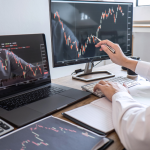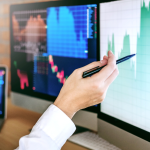6 Pieces of Advice for Re-starting Trading After a Prolonged Pause
After months or even years away from the markets, the idea of resuming an active trading strategy can feel both exciting and nerve-wrecking.
You’ve kept up with global events from the sidelines, and watched countless charts and indicators in observation mode only. But now it’s time to actually put some real capital to work again—how do you ease back into action safely and set yourself up for success?
As someone who has gone through periods of stepping away and then restarting my own trading activities, I have some insights I’ve learned the hard way that may help smooth your transition.
Consider these six tips from my own experience for getting back up to speed as you dip your toes in the trading waters once again.
Refresh Your Market Knowledge
No matter how much time has passed since your absence, it is important to acknowledge that the world has continued to progress and evolve, leading to changes in various aspects of life. In order to reintegrate yourself into the current state of affairs, it is crucial to conduct thorough research.
To stay in the know, it’s important to stay informed about significant economic reports, ongoing trade negotiations, changes in monetary policies, leadership transitions, and noteworthy technological advancements that could impact different sectors or regions. By doing so, you’ll be able to understand the current dynamics and make informed decisions.
Furthermore, it is advisable to acquaint yourself with the latest trading tools and services that are available. In this competitive environment, knowledge is a valuable asset, and being well-informed before making any decisions is of utmost importance.
Examine Your Plan of Action
When analysing past triumphs, it is important to take a closer look at the strategies that were implemented to achieve success. This involves examining the specific actions taken, the resources utilised, and the overall approach that was adopted.
By doing so, we can gain valuable insights into what worked well and what did not, and use this information to inform future decision-making.
In addition, it is also important to consider any challenges that were faced during the process. This could include obstacles such as limited resources, unexpected setbacks, or resistance from stakeholders. You might want to think about adjusting or even completely changing your strategy to match your improved skills and perspective.
Before actually investing your money, it’s a good idea to test out the updated systems on paper first. Strategies that used to be effective may need some fine-tuning to adapt to the current climate. By understanding these, we can better prepare for similar situations in the future and develop strategies to overcome them.
Kick-off with a modest start
During this period of adjustment, it is important to take the time to understand the intricacies of the market and how it behaves. By starting with smaller position sizes, you can mitigate the risk of significant losses while you gain experience and confidence in your trading abilities.
By gradually increasing your volume and exposure, you allow yourself the opportunity to observe and analyse the patterns and fluctuations of prices. This allows you to develop a better understanding of market dynamics, identify trends, and make more informed trading decisions.
Additionally, this gradual approach assesses your own risk tolerance and comfort level with different position sizes. It is crucial to find a balance that aligns with your individual trading style and financial goals.
By taking the time to familiarize yourself with the market and gradually increase your position sizes, you can build a solid foundation for successful trading and minimize the potential for costly mistakes.
Keep a lid on your emotions
Taking a break from trading can be a refreshing and rejuvenating experience. It allows you to step back from the constant fluctuations of the market and regain a sense of perspective. However, when you return to trading, it is common to feel a surge of excitement or nervousness. This surge is a natural response to the anticipation of a new beginning, a fresh opportunity to make profitable trades.
However, it is crucial to remember that trading involves emotions. If you allow your feelings to overpower logical thinking, it can lead to costly mistakes. Emotions such as fear, greed, and recklessness can cloud your judgment and cause you to make impulsive decisions that may result in significant losses.
As you gain more experience in trading, you will likely become better at staying detached from your current emotions. You will learn to make decisions based on rational analysis rather than being swayed by momentary feelings.
Pause and reflect on your mindset
Taking the time to reflect on one’s mindset is an essential step in ensuring successful trading. It is crucial to assess whether you still possess the necessary qualities such as patience, discipline, and perseverance to navigate the unpredictable nature of the markets.
Life experiences can sometimes weaken one’s mental strength over time, so it is important to evaluate if any personal setbacks or challenges have affected your ability to handle the ups and downs of trading.
When making trading decisions, it is important to consider whether you rely solely on data or if personal biases come into play. In my case, personal biases cloud judgment and lead to irrational decision-making, so it is crucial to be aware of any biases and strive to make objective decisions based on reliable data.
Furthermore, it is essential to evaluate whether you still maintain a learning-focused approach towards the markets. If frustration and impatience have taken over, it can hinder progress and prevent one from adapting to new market trends and strategies.
Don’t lose sight of the bigger picture
Finally, always keep in mind that trading is a journey filled with ups and downs. No one, not even myself, is immune to experiencing losses or going through a rough patch. It’s important to respect your trading process and focus on improving over time rather than solely on short-term outcomes.
Taking breaks from trading can skew your perception of risk, so it’s crucial to maintain a proper perspective on position sizing in relation to your overall portfolio. Remember to concentrate on the process rather than getting caught up in short-term wins or losses.
With the right mindset and preparation, you have the potential to achieve your trading goals. Believe in yourself and your ability to bounce back from any market challenges that come your way. Undoubtedly stepping away can give valuable perspective, but trading still requires active participation.
I promise these tips provide a framework for smoothly stepping back into market participation following your break. With diligent work on strategy, mindset, and risk controls, you have every opportunity to hit the ground running profitably in the months ahead.
Now get out there and put your insights and experience to work once more!





